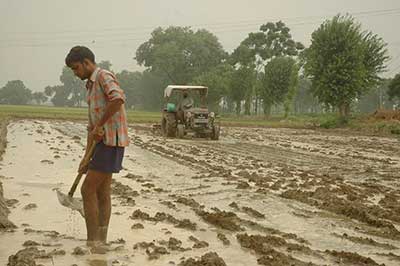Date: 22/10/2022
Relevance: GS-3:Climate Change, Agriculture Cropping Pattern and issues related to it.
Key Phrases: Climate Change, Rabi and Kharif crops, Heatwave, Price Inflation, Hailstorm, Drought, Lumpy Skin Virus, Climate Adaptation, ICAR, PM Crop Insurance Scheme, Patent-free Climate Resilient Seeds, Multi-cropping and Inter-cropping.
Context:
- According to the Climate Transparency Report 2022, Between 2016–2021, extreme events such as cyclones, flash floods, and landslides caused damage to crops in over 36 million hectares, a $3.75 billion loss for farmers in India.
Key Highlights:
- Food and Agriculture Organisation's (FAO) assessment showed that the decade spanning 2010–2019 was the most turbulent for disasters.
- The State of Food Security and Nutrition in the World (SOFI) 2022
highlights the intensification of the major drivers of food insecurity:
- conflict, climate extremes, and economic shocks, combined with growing inequalities
- Heat exposure in the country led to the loss of 167 billion potential labor hours.
- In India, local precipitation is projected to increase by 6 percent from the reference period of 1986-2006 at 1.5°C of warming.
Cropping Season of India
- India has three cropping seasons-
- Kharif:
- These crops are also called “Monsoon Crops''.
- These crops are grown at the onset of monsoon in July and harvested in sep-oct.
- Requires more water.
- Major crops: paddy, maize, jawar, bajra, moong, urad, cotton, jute, groundnut, and soya bean, etc.
- Rabi:
- These are also known as “Winter Crops”.
- Sowing of these crops occurs in winter(Oct-Nov) and harvesting in summer (Feb-April).
- Rabi crops need cold weather for growth and less water than Kharif crops.
- Major crops: wheat, gram, mustard, barley, and peas.
- Availability of precipitation during winter months due to the western temperate cyclones helps in the success of these crops.
- Zaid:
- Short season during the summer months which, comes between the rabi and the Kharif seasons.
- It requires warm and dry weather for growth.
- Major Crops: watermelon, muskmelon, cucumber, etc.
- Kharif:
Major Climatic Events:
- Heat Wave:
- The abnormal increase in maximum and minimum temperatures during 2022 impacted crops, fruits, vegetables, and animals.
- For example, North India was hit with heatwaves, hitting wheat harvest across Punjab, Haryana, and UP.
- Excessive Rain:
- Heavy rainfall in India has damaged key summer-sown crops such as rice, soybean, cotton, pulses, and vegetables just before harvesting.
- For example, farmers in Meghalaya have been hit by untimely and excessive rains damaging ginger to forest edibles.
- Drought:
- India was identified as one of the most severely drought-affected countries in the assessment.
- Drought affected nearly two-thirds of the country from 2020 to 2022.
- As per sources, India's drought-prone area has increased by 57% since 1997.
- Cyclone:
- Heavy rains, brought by a cyclone, damage crops, and vegetables just before harvesting in key growing regions.
- For example, Cyclone Tauktae was the strongest storm to hit the west coast of India in over 20 years which damaged the crops before harvesting.
FAO
- The Food and Agriculture Organisation (FAO) is a specialized agency of the United Nations, founded in 1945 and headquartered in Rome, Italy.
- It leads international efforts to defeat hunger and improve nutrition and food security.
- The State of Food Security and Nutrition in the World Report is published jointly by FAO, IFAD, UNICEF, WFP, and WHO.
Lumpy Skin Disease
- Lumpy skin disease is a viral disease of cattle caused by a Lumpy skin disease virus.
- The World Organization for Animal Health categorizes LSD as a notifiable disease.
- It is characterized by fever, reduced milk production, and skin nodules.
Effects of Climate Change:
- Changing weather patterns are creating significant challenges for
farmers across the country. Some of them are given below-
- Loss of crop Production:
- Crop production is projected to decrease in many areas during the 21st century because of climatic changes.
- Higher temperatures tend to reduce crop yields and favor weed and pest proliferation.
- Climate change can have negative effects on irrigated crop yields across agroecological regions both due to temperature rise and changes in water availability.
- Price Inflation:
- Climate change is altering weather patterns, directly impacting 55 percent of the country’s inflation basket.
- For example, a heatwave in March played havoc with the wheat
crop.
- Despite a ban on exports, wheat prices have risen 19 percent.
- Loss of crop Production:
Way Forward:
- Short Term Measures:
- Expand PM Kisan Insurance Scheme to include climate damage.
- Insurance companies should compensate for crop value.
- Steadfast mechanism to report directly to insurance companies.
- Third-party audit to verify farmer’s claims.
- Long-Term Measures:
- Abandon the green revolution paradigm
- It will ensure climate adaptation and nutrition security.
- Research and Development on climate resilient agriculture.
- More funds need to be allocated for R&D purposes.
- Increase Private sector participation.
- Govt must encourage private sector participation in seed division.
- Indian companies should be invited to expedite R&D on climate resilience.
- Development and identification of climate-resilient seeds.
- It should be used for vulnerable areas and emergency situations.
- Encourage multi-culture and inter-cropping.
- Monoculture practices should be discouraged.
- Promotion of Organic farming.
- It will cut down the bills of subsidy and ensure nutrition security.
- More funds should be given to improve organic farming and organic produce markets.
- Natural methods to mitigate climate change should be promoted.
- Govt should incentive the growing of agro-climatic zone-specific crops.
- Development of Patent-free climate seeds & technologies.
- Abandon the green revolution paradigm
Conclusion:
- Ecologically sound agriculture policy towards climate adaptation is the need of the hour to mitigate the negative effects of climate change on agriculture.
Source: The Hindu BL
Mains Question:
Q. What are the issues faced by agriculture due to bad weather? Suggest the measures that can be taken to reorient the ecologically unsound agriculture policy. (200 Words).







